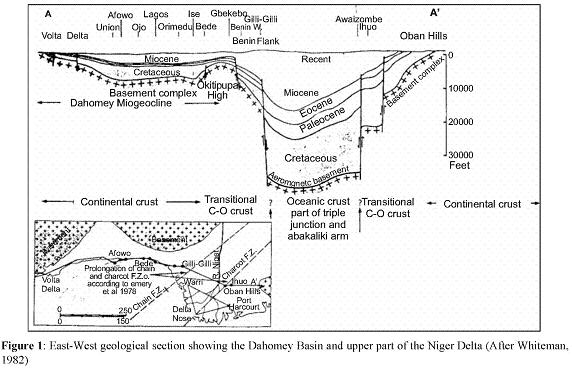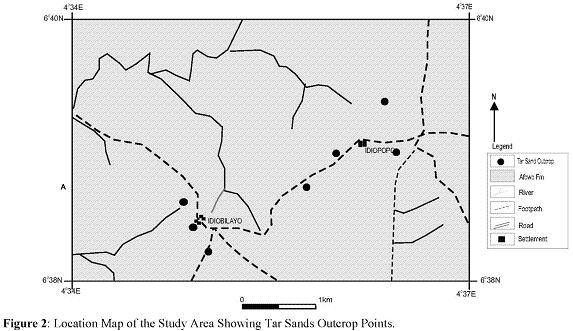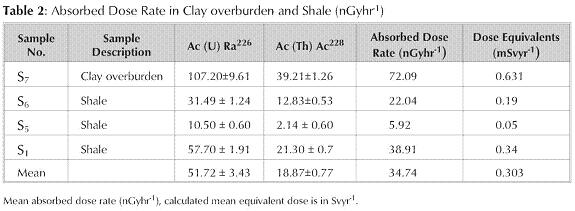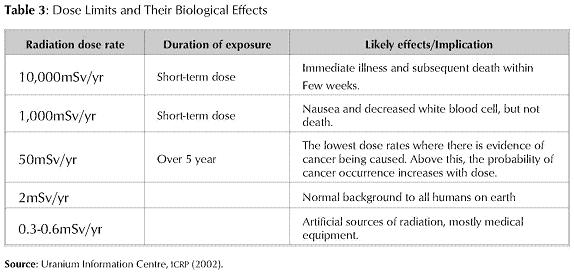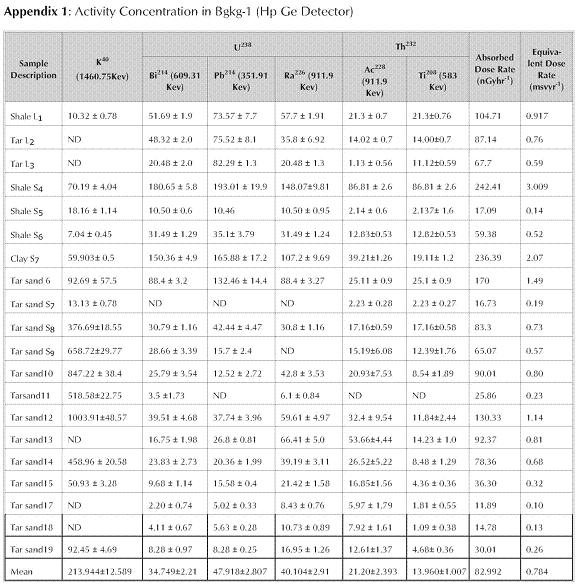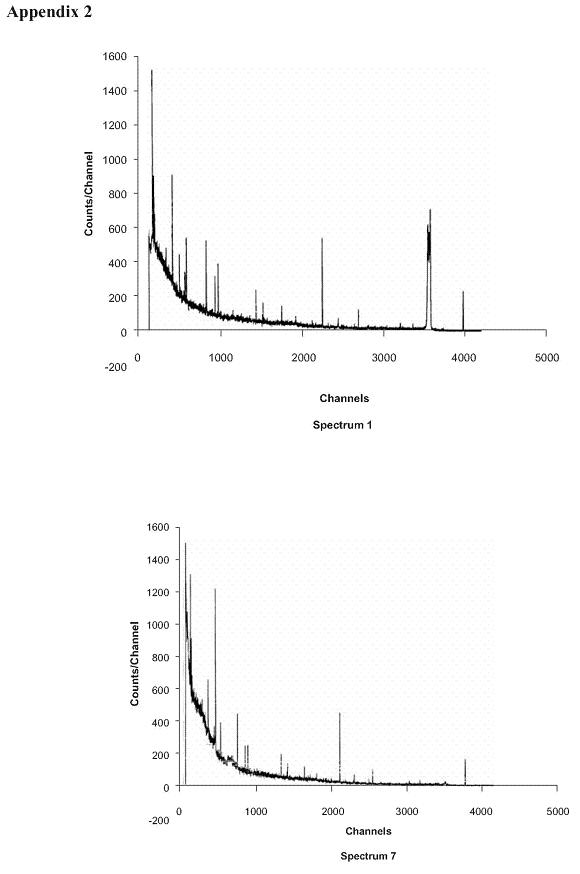Servicios Personalizados
Revista
Articulo
Indicadores
-
 Citado por SciELO
Citado por SciELO -
 Accesos
Accesos
Links relacionados
-
 Citado por Google
Citado por Google -
 Similares en
SciELO
Similares en
SciELO -
 Similares en Google
Similares en Google
Compartir
Earth Sciences Research Journal
versión impresa ISSN 1794-6190
Earth Sci. Res. J. v.13 n.1 Bogotá ene./jun. 2009
RADIOGENIC COMPONENTS OF THE NIGERIAN TAR SAND DEPOSITS
Akinmosin, A.1, Osinowo, O.O.2 and Oladunjoye, M. A.2
lDepartment of Earth Sciences, Olabisi Onabanjo University, Ago-Iwoye. Nigeria
2Department of Geology, University oflbadan, Ibadan. Nigeria
Corresponding author Email: wale.osinowo@mail.ui.edu.ng
Manuscript receiver: January 07th, 2009. Accepted for publication: June 15th, 2009.
ABSTRACT
A combination of factors has prevented the exploitation of the Nigerian tar sand deposits to date, among which is the environmental factor which may pose some dangers to both physical and biological components of the area of occurrence. Gamma ray spectrometric analysis was carried out on samples of bituminous sand deposits in parts of Southwestern Nigeria.
The aims were to determine the presence and level of radioactivity of selected radionuclides and to assess the possible impact on the environment, and provide geochemical baseline that could be useful in planning appropriate environmental management programs that will reduce potential negative effect of exploiting the resources on the environment.
Twenty air-dried samples collected for this study were weighed and sealed for 28 days to enable them attain a state of secular equilibrium. They were subsequently analyzed for gamma-emitting radionuclides using Gamma-ray Spectrometer fitted with a calibrated Canberra vertical coaxial High purity Germanium Detector (HpGe) system.
The radio nuclides identified with reliable regularity belong to the decay series of naturally occurring radio nuclides headed by 238U, 232Th and naturally occurring 40K. Result showed that the radiogenic composition of the clay overburden (0.631mSvy-1), shale-(0.193mSvyr-1), and bituminous sand (0.446mSvyr-1), are lower than the normal background value considered harmful to man.
Key words: Spectrometric, Gamma ray, radionuclides, Nigerian.
RESUMEN
Una combinación de factores ha evitado la explotación de los depósitos de arena bituminosa de Nigeria hasta la fecha, en ellos el factor ambiental plantea algunos peligros para los componentes físicos y biológicos de la zona. Se realizó un análisis de Espectrometría de rayos gamma a las muestras de los depósitos de arena bituminosa en partes del suroeste de Nigeria.
Los objetivos fueron determinar la presencia y el nivel de radiactividad de determinados radio nucleídos para evaluar el posible impacto sobre el medio ambiente, y proporcionar un referente geoquímico que sería útil en la planeación de programas de manejo ambiental que redujeran los posibles efectos negativos de la explotación de los recursos al medio ambiente.
Para el desarrollo de este estudio se tomaron veinte muestras las cuales fueron pesadas y selladas durante 28 días a fin de que puedan alcanzar un estado de equilibrio secular. Un análisis de emisión de rayos gamma por radio nucleídos fue realizado posteriormente con un espectrómetro de rayos gamma equipado con un detector coaxial vertical de Germanio de alta pureza (HpGe).
La radio nucleídos, identificados con una regularidad confiable, pertenecen a la serie de radio nucleídos de desintegración natural, encabezada por 238U, 232Th y 40K. Los resultados mostraron que la composición radiogénica de la arcilla (0.631mSvy-1), de las lutitas-(0.193mSvyr-1), y de la arena bituminosa (0.446mSvyr_1). son inferiores al valor mínimo, considerado dañino para el hombre.
Palabras clave. Espectrometría, Rayos Gama, radio nucleídos, Nigeria.
1. Introduction
Tar sand is composed of a mixture of bitumen, which makes up about 10-20% and about 80-85% mineral matter including sands, clays and 4-6% water. Tar sand has similar composition as the light crude (i.e. H, C and minor amount of S and O). They are believed to have formed from biodegradation and water-washing of light crude due to lack of cap rock. The Nigerian Tar sand is believed to have formed in a similar process. Trace elements occur naturally in rock forming minerals and ore minerals; hence they can reach the environment from natural processes. Weathering is a physical and chemical processes that breakdown rocks and then release these trace elements naturally into the environment.
The Dahomey basin (Fig. 1) is a marginal pull-apart basin (Klemme, 1975) or Margin sag basin (Kingston et al., 1983), which was initiated during the early Cretaceous separation of African and South American lithospheric plates. Occurrence of seepage and tar sand deposits over the Okitipupa ridge in the Dahomey basin provided the initial impetus for oil exploration in Nigeria. From the turn of 19th century up till date, no less than over twenty groups comprising public and private ventures have shown degrees of interest. The occurrence of these deposits has been known since early last century, however, intense investigations commenced from mid 70's till now. The pioneering efforts were initiated by the Geological Consultancy Unit of the University of Ife (now Obafemi Awolowo University). The geology of these deposits, oil saturation and reserve estimates as well as textural characteristics of the associated sands has been described (Adegoke et al., 1980, and 1981; Enu, 1985). The physiochemical properties of the bitumen in relation to production and processing have been studied (Adegoke et al., 1980; Oshinowo et al., 1982; Ekweozor, 1985; Oluwole et al., 1985). The origin of the bitumen has been considered (Coker, 1982; Ekweozor, 1985). Other relevant studies on the deposit include works done by Ako et. al (1983); Ekweozor (1986 and 1990); Ekweozor and Nwachukwu (1989); Enu (1987, 1990); Enu and Adegoke (1984). These works have highlighted relevant aspects of the geochemical and sedimentological characteristic of the deposit.
A combination of factors has prevented the exploitation of this resource to date; the most important is the environmental effects that may pose treat to both physical and biological components in the area of occurrence. It is therefore, of utmost importance to know the average background amounts of each metal in the natural uncontaminated geological materials, soils, and waters before assessing the contribution of anthropogenic sources to environmental contamination that may be associated with mining project when it eventually commences.
Stratigraphy of the Dahomey Basin
The study area lies within latitude 0060381N- 0060401N and longitude 0040341E- 0040371E (Fig. 2), and falls within the eastern Dahomey Basin. The reviewed work of Omatsola and Adegoke (1981) on the Cretaceous stratigraphy of the Dahomey basin has recognized three formations belonging to the Abeokuta group. These are: the Ise Formation, consisting essentially of continental sands, grits and siltstones, overlying the basement complex uncomformably. Neocomian to Albian age has been assigned to this formation. Overlying the Ise Formation is the Afowo Formation, which consists of coarse to medium-grained sandstones with variable interbeds of shales, siltstones and clay. The sediments of this formation were deposited in a transitional to marginal marine environment. Turonian to Maestritchtian age has been assigned to this formation. The Araromi Formation consists essentially of sand, overlain by dark-grey shales and interbedded limestone and marls with occasional lignite bands. The formation conformably overlies the Afowo Formation and Maestrichtian to Paleocene age has been assigned (Omatsola and Adegoke, 1981).
Overlying the Abeokuta group conformably is the Imo group, which comprises of shale, limestone and marls. The two-lithosratigraphic units under this group are: Ewekoro Formation that consists of thick fossiliferous limestone. Adegoke (1977) described the formation as consisting of shaley limestone 12.5m thick which tends to be sandy and divided it into three microfacies. Ogbe (1972) further modified this and proposed a fourth unit, which he said is Paleocene in age and associated with shallow marine environment due to abundance of coralline algae, gastropods, pelecypods, echinoid fragments and other skeletal debris. Akinbo Formation lies on the Ewekoro Formation and it comprises of shale, glauconitic rock bank, and gritty sand to pure grey sand with little clay. Lenses of limestone from Ewekoro Formation grades laterally into the Akinbo shale very close to the base. The base is characterized by the presence of a glauconitic rock. The age of the formation is Paleocene to Eocene.
Overlying the Imo group is the Oshoshun Formation; it is a sequence of mostly pale greenish-grey laminated phosphatic marls, light grey white-purple clay with interbeds of sandstones. It also consists of claystone underlain by argillaceous limestones with light grey shale at the bottom. There are inclusions of phosphatic and glauconitic materials in the lower part of the formation and the upper part is made up of medium to coarse-grained silty sandstone (Adegoke, 1969). The formation is Eocene in age (Agagu, 1985). The sedimentation of the Oshoshun Formation was followed by a regression, which deposited the sandstone unit of Ilaro Formation (Kogbe, 1976). The sequence represents mainly coarse sandy estuarine deltaic and continental beds, which show rapid lateral facies change.
The coastal plain sands are the youngest sedimentary unit in the eastern Dahomey basin, it probably overlay the Ilaro Formation unconformably, but convincing evidence as to this is lacking (Jones and Hockey, 1964). It consists of soft, poorly sorted clayey and pebbly sands, of Oligocene to Recent age.
Method of study
Gamma Ray Spectrometric analysis was carried out on twenty samples. These samples were transferred from the bags into clean air-tight containers and sealed for 28 days in order for the samples to attain secular equilibrium and also to prevent escape of Ra-226 gas. Moreover, an empty clean container was equally weighed and sealed for minimum number of days to serve as the background count.
Various detectors have been used to measure radiation energy deposited in a medium. The choice of a detector for low counting revolves around many factors, but energy resolution and counting efficiency are the most important. Two types ofdetectors used in this work are: inorganic scintillation counter sodium iodide (NaI) activated with thalium (TI), and the other is high purity germanium detector (HPGe).
After a minimum of 28 days for the sealed samples to attain secular equilibrium, each sample was placed on HPGe detector enclosed in a lead shield and counted for 10 hours (36 000 s). An identical but empty container that has been sealed for same 28 days was also counted for 10 hours. A standard soil sample that contains certified radioactivity concentration due to 238U, 232Th and 40K by weight was also counted for 10 hours. The high resolution of HPGe detector made identification of a wide spectrum of y-ray energy in the samples possible, and the photo peaks observed with regularity in the samples were identified. The area under each peak from the spectra produced was analyzed using a spectra analysis program, SAMPO-90, which matched y-energies at various energy levels to a library of possible radioisotopes. The background peak height area was subtracted from the standard peak area in order to get net-peak area values for both the standard and the sample respectively.
Results and discussion
The measured radioactivity concentration (Bqkg-1) of gamma emitting radionuclides in the samples is presented in Appendix 1. It was observed that the radionuclides identified and quantified from the gamma ray spectral (Apendix2) are decay daughter products of naturally occurring radioactive element 238U and 232Th. The radioactive daughter product of 238U, are 214Bi, 214Pb and 226Ra, likewise the daughter products of 232Th are 208Ti and 228Ac. 40K that is also naturally occurring but a non series radioactive isotope was also detected and selected for analysis at 1460.75keV. Radionuclides were detected in all samples analyzed for, but in varying proportions. For instance, naturally but non-series 40K was detected at 1460.75keV in all the samples except in Tar L2, Tar L3, Tar sand 13, Tar sand 17 and Tar sand 18; there activity values range between 7.04 ± 0.45Bqkg-1 and 1003.91 ±48.57Bqkg-1
The 238U series are more prominent in the samples analyzed than the 232Th series.214Bi activity values range between 5.02 ± 0.33Bqkg-1 and 193.01 ± 19.94Bqkg-1; 226Ra activity values range between 6.10 ± 0.84BgKg-1 and 148.07 ± 9.81BgKg-1; 228Ac activity values range between 2.14 ± 0.60Bqkg-1 and 53.66 ± 4.44Bqkg-1; 208TI values range between 1.09 ± 0.38Bqkg-1 and 86.81 ± 2.6Bqkg-1. The absorbed dose rates in air calculated from the radioactivity concentration of the various samples are given in Tables 1 and 2 for the overburden, shale, and tar sand respectively. The corresponding absorbed dose rates have been calculated using the relationship derived by Beck et al (1972) which is given as:
D = 0.042Ac (K) + 0.429Ac (U) +0.666 Ac (Th)
Where D is in Gyhr-1 and represents the absorbed dose rate in air due to the specific activity concentrations of Ac (K).Ac (U) and Ac (Th) in (Bqkg-1), respectively.
The result may be compared with those units set by the International Commission on Radiological Protection (ICRP) as shown in Table 3. It could be established that the mean dose equivalent calculated for clay overburden 0.631m Svyr-1, shale 0.193m Svyr-1 and bituminous sand 0.446m Svyr-1 are still lower than the normal background value to all humans on earth considered harmful or hazardous to the environment.
Conclusion
The presence of radioactive elements in an environment has been a source of concern, under certain conditions; they can generate a significant radiation that canbe injurious to health. The result of the study using gamma spectrometric method of analysis indi-
cated that the radionuclides identified and quantified belong to the naturally occurring decay series of 238U and 232Th. The naturally occurring non-decay isotope 40K was also identified and quantified. Although the radioactivity levels of the radionuclides were found to be low.
The natural gas 226Ra, that is generally associated with petroleum from decay of uranium and thorium is noted in the bituminous sands in relatively low concentration. The specific activity of these radionuclides in the bituminous sands is not expected to cause any health hazards now, but the mode ofex-ploitation and extraction can still raise the level if not cautiously chosen and adopted in future. Open cast mining method might concentrate and lead to radiation of some of these elements in the overburden during excavation and thus could have severe health implication.
References
Adegoke, O.S. 1969. Eocene Stratigraphy of Southern Nigeria, Bulleting Bureau de Research Geologic ET Miners Memoirs. Vol. 69 pp 22-243. [ Links ]
Adegoke, O.S. 1977. Stratigraphy and paleontology of the Ewekoro Formation (Paleocene) of SW Nig. Bull. Am. Paleontol; vol.71, No 295,375 pp. [ Links ]
Adegoke O.S., Ako, B.D., Enu, E.I. 1980. Geotechnical investigations of the Ondo State bituminous sands. Vol. 1. Geology and reserve estimate. Rept. Geological Consulting Unit, Dept. ofGeology, University ofIfe. 257pp. [ Links ]
Agagu, O.K., 1985. A geological guide to bituminous sediments in Southwestern Nigeria. Unpubl. Rept. Dept. ofGeology, University ofIbadan. [ Links ]
Ako, B.D., Alabi, A.O., Adegoke, O.S., and Enu E.I., 1983. Application of Resistivity sounding inexplorationforNigerianTarSand, Energy Exploration and Exploitation Vol. 2, No 2. Pp.155-164. [ Links ]
Beck, H. L, DeCampo, J. and Gogolak, C., 1972. In-situ Ge(Li) and NaI(Tl) Gamma ray spec-trometry. Rept. HASL-258, U.S Atomic Energy Comm. [ Links ]
Coker S.J.L. 1982. Some aspects of the geology of the bituminous sands ofparts ofthe BeninBasin. Nig. Min. and Geosc. Soc. 19, pp121. [ Links ]
Ekweozor, C.M. 1985. NigerianTar Sands. Bitumen chemical properties and their relation to origin, production and processing. Book of Abstracts: 21st Ann. Conf. Nig. Min. & Geosc. Soc., Jos Nigeria, 11th-15th March 1985. [ Links ]
Ekweozor, C.M. 1986. Characteristics of the non-asphaltene products ofmildchemical degradation of asphaltene. Org. Geochem. 10. Pp. 1053-1058. [ Links ]
Ekweozor, C.M., 1990. Geochemistry of oil sands of southwesternNigeriaIn: B.D. Ako, E.I. Enu(editors), Occurrence, utilization and economic of Nigerian tar sands:A workshop held in Ogun State University Ago-Iwoye, Nigeria on 29-31 May, 1990.Published by the Nigerian Mining and Geosciences Society, Ibadan chapter, 50-62. [ Links ]
Ekwezor, C. M., and Nwachukwu, J. I., 1989. The origin of Tar sands of southwestern Nigeria. NAPE Bull. 4, 80-94. [ Links ]
Enu, E.I., 1985. Textural characteristic of the Nigerian Tar Sands. Sedimentary geology. V. 44, pp 65-81. [ Links ]
Enu, E.I., 1987. The paleoenvironment of deposition of late Maastrichtianto Paleocene black shales in the eastern Dahomey basin, Nigeria Geologie en Mijinbouww. 66 pp, 15-20. [ Links ]
Enu, E.I., 1990. Textural and occurrence of tar sands in Nigeria In: B.D. Ako, E.I. Enu (editors), Occurrence, utilization and economic of Nigerian tar sands: A workshop held in Ogun State University Ago-Iwoye, Nigeria on 29-31 May, 1990.Published by the Nigerian Mining and Geosciences Society, Ibadan chapter, 11-16. [ Links ]
Enu, E.I., and Adegoke, O.S., 1984. Potential industrial mineral resources associated with the Nigeria tar sands. 27th international geological congress Mosco. Book of abstract. Vol. Vii, pp 345. [ Links ]
International Commission on Radiological Protection (ICRP), 2002 [ Links ]
Jones M.A and Hockey R.O., 1964. The Geology of Part Of South Western Nigeria.Nig.Geol.Surv. Bull.No31, 1-101. [ Links ]
Klemme, H.D., 1975. Geothermal Gradients, Heatflow and Hydrocarbon Recovery. In : A.G. Fischer and S. Judson (eds), Petroleum and Global Tectonics. Princeton, New Jersey, Princeton Univ. Press, pp. 251-304. [ Links ]
Kingston, D.R., Dishroon, C.P. and Williams, P.A. 1983. Global basin classificationsystem. American Association of Petroleum Geologists. Bulletin 31, 87p. [ Links ]
Kogbe, C.A., 1976. Geology of Nigeria. (Second revised edition). Published by Rock View (Nig.) 455pp.C.A Kogbe (editor). [ Links ]
Ogbe F.G.A. (1972): Stratigraphy of Strata Exposed In Ewekoro Quarry, Southwestern Nigeria. In: Africa Geology pp305-322. [ Links ]
Oluwole, F.F., Adegoke, O.S., Kehinde, L.O., Borishade, A.B., Ako, B.D., Ajayi, T.R., Enu, E.I., Nwachukwu, J.I., Coker, S.J.L., Wallace, D., Asubojo, O.I and Ogunsola, O., 1985. Chemical composition of bitumen extracts from Nigerian tar sands. In: Proceedings of 3rd Intern. Confer. On heavy Crude and Tar sands; Long Beach California; chap. 33, pp 373-379. [ Links ]
Omatsola M.E and Adegoke O.S. (1981): Tectonic and Cretaceous Stratigraphy Of Dahomey Basin Jour. Of Min. Geol. Vol.54, pp 65-87. [ Links ]
Oshinowo, T., Ademodi, B. and Adediran, A.S., 1982. Bituminous tar sand of Nigeria. Analysis of oils-Part 1. Jour. Nig. Soc. Chem. Engrs. 1, 44-48. [ Links ]
Taylor, S.R., 1964. Abundance of chemical elements in the continental crust; a new table. Geochim Cosmochim Acta, 28. 1273-1285. [ Links ]
Whiteman, A.J., 1982. Nigeria: Its Petroleum Geology, Resources and Potential, Vol. 2, Graham and Trotman, London. [ Links ]













